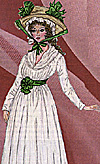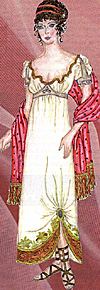
 Chemise dress with a drawstring neck and kerchief tuked into the bodice, circa mid-1790s.
Chemise dress with a drawstring neck and kerchief tuked into the bodice, circa mid-1790s.
Following the end of the Reign of Terror, there was a revival of interest in luxurious fashions for those who could afford them. Elaborate hats and bonnets liberally trimmed with ribbons and bows replaced the plainer caps that had been favored in the early 1790s. Full soft curly hairstyles which appeared "natural" but were actually quite complicated remained stylish. Most fashionable women, with the exception of a few aristocrats, has stopped powdering their hair. the simple white cotton chemise dress, which had first appeared in the 1780s, was extremely popular. By the mid 1790s, the waistline had risen slightly and women often wore colorful sashes with their pale gowns.
 High waisted gown with geometric trim and a decorative scarf, circa late 1790s.
High waisted gown with geometric trim and a decorative scarf, circa late 1790s.
By the late 1790s, the waistline had moved up to just below the breasts, but the skirt was still slightly full, especially towards the back. Though the moralists and satirists decried the scandalous nature of fashionable attire during the Directory, not all gowns had extremely low necks. Though white and pastels were themost popular colors, many fashion plates also show gowns in vivid hues. The vogue for sashes, scarves, shawls, high waistlines, and geometric patterns reflected the French interpretation of ancient Greek and Roman design. Dresses themselves were simple, but the trimmings were increasingly elaborate and exotic.
 Gown, probably a ball gown, showing excessive "Greco-mania", circa 1800
Gown, probably a ball gown, showing excessive "Greco-mania", circa 1800
The decorative arts had increasingly favored Greek and Roman motifs since the mid-1700s, but by 1800, ultra-fashionable women wore extreme versions of what they believed were ancient styles. Dancing, especially the new and scandalous waltz, had become popular duringthe Directory, and affluent people regularly held balls at which fashionable women displayed their most elaborate "ancient" ensembles. Gowns had become narrower andteh abandonment of petticoats, rigid corsets, and stiff paniers shocked moralists. Moreover, the new cottons were softer and more fluid and revealed the shape of the female body more than the satins and brocades of the ancien regime. Women did not completely abandon their underclothing, and not all fashionable gowns were transparent, but they seemed so in contrast to the previous era.
Color Illustrations of Women's Fashion
Back to One Excess: Women's Fashion
Back to Table of Contents -- Napoleon #5
© Copyright 1996 by Emperor's Press.
This article appears in MagWeb (Magazine Web) on the Internet World Wide Web.
The full text and graphics from other military history magazines and gaming magazines are available at http://www.magweb.com